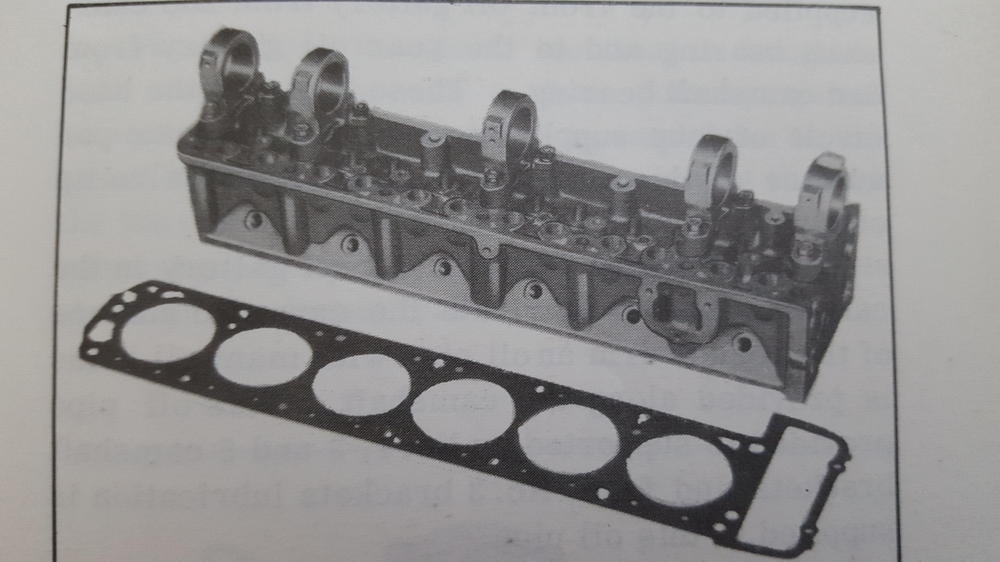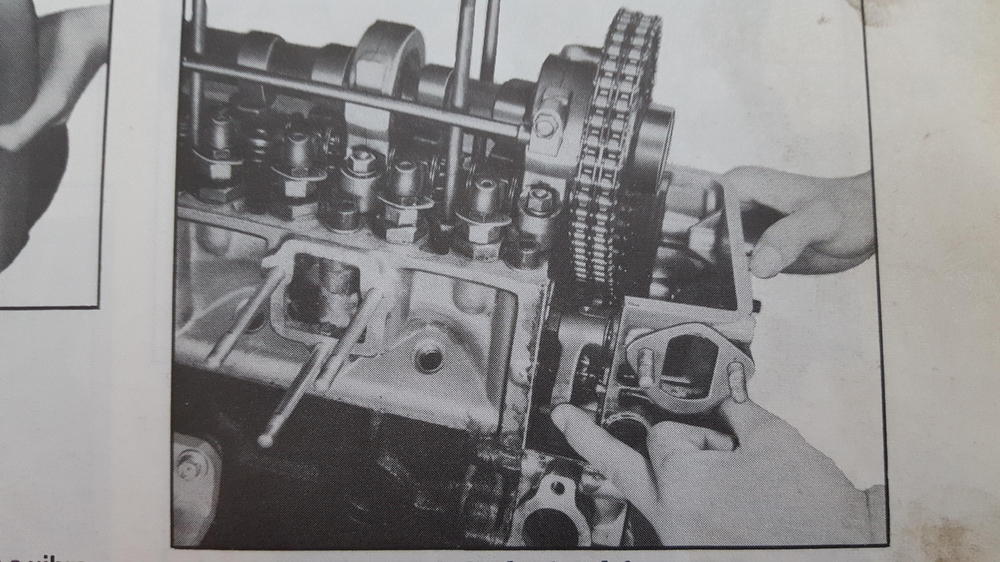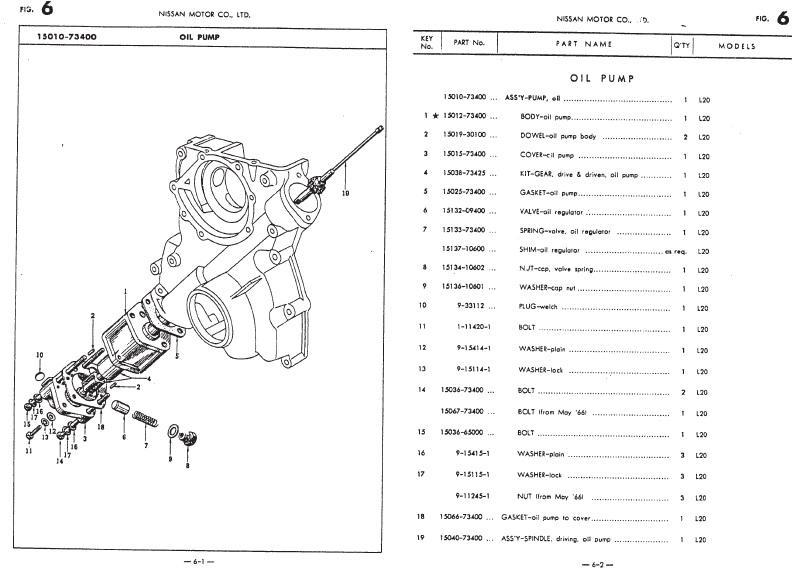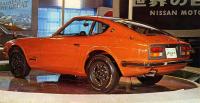Everything posted by HS30-H
-
Fairlady 432 at Auction
"HS30"...? Not used on HS30 production cars. It was actually an S30-S 'Z-Std' part.
-
Fairlady 432 at Auction
...and these are the interiors of two different Works race cars, so starting to blur the lines between what's *correct* for a factory race PZR or 240ZR and the product used for homologation/sale to the general public.
-
Fairlady 432 at Auction
That's a complete fibreglass dash cover. Nothing to do with the 432 or 432-R whatsoever.
-
R180 Identification
Kameari Engine Works in Japan manufactured 3.1, 4.875 and 5.1 CWP sets for the R200 when the OEM supplies dried up. Nothing for the R180, as far as I am aware.
-
R180 Identification
Manually count the crownwheel teeth and pinion teeth to be sure. As far as I am aware (and I just checked the Nissan Sports 'Final Drive & Limited Slip' factory bible to be sure) only the R200 was available with a 3.1 (actually 3.151) ratio, with a 41 tooth crownwheel and 11 tooth pinion. Lowest numerical ratio on the R180 was the 3.364.
-
HLS30-00006 at the Crusher?
What I'm doing is applying 1969 standards to a 1969 event. As I've already pointed out, the Japanese press carried coverage - including their own photos - of the Ginza Press Preview event, so what was stopping the American press from taking/using their own photos at the NY and LA "International Preview" (sic) events? I just don't buy the "cost of a photographer and delay" line. Press photography processing was fast enough to keep up with copy at the time, and this is hardly 'Hold the front page!' stuff, is it? Yes, the press pack photos allowed control of images used in publication, but that would need to go hand-in-hand with a request of 'No Photos' at the events themselves. The problem is that the NY and LA hotel events do not live up to the hype. That hype - I'm all ears if you have an alternate suggestion - appears to be exclusively the domain of zhome.com. and its presentation of the Pierre Hotel event as something bigger and more important than it really was. It seems that there's a desire to somehow trump any other event, or at least diminish. The 18th October Ginza Press Preview doesn't even get mentioned. Ironically, this - it seems to me - is exactly what Katayama and other figures at NMC USA were trying to achieve, with the NY and LA hotel events arranged in haste as an answer to the bigger events happening in Japan. If I was them I would not want to be trumped/overshadowed either, so I have some sympathy. zhome tells us that: So, let's get this straight. According to zhome and/or Dunn/Cheney, a car arrived by air from Japan and was in the Pierre Hotel by 16th October. Or had it arrived from Japan "the week before" the 16th? It's hard to tell from the way it is written. And this is "just in time" for an event taking place on the 22nd? A week...? What were they actually doing for seven days? The - single - photo I've seen of this event shows a car standing in front of some curtains. Maybe it took a long time to find the right curtain hooks...? No photographers, or just no cameras? Maybe no film!? Sounds like a nice little treat though. Yeah. A week. I guess they had that charter flight fuelled up, armed with finger food and well-stocked drinks trolleys, APU running, just waiting for the Fire Marshall to give the green light before they sent out the invitations to the guys in Detroit. Or just maybe this tale got taller in the telling...? Fans of 'colorized' photos might like to note that zhome tells us the NY Pierre Hotel car was then flown out to Los Angeles for the LA hotel event. You might want to adjust the colour balance on your monitor to mitigate this.
-
HLS30-00006 at the Crusher?
Since we are hypothesising, here's an educated guess from me regarding the NY Pierre Hotel and LA 'Trunk Show' (that's what I'm calling them...) events: I have never seen any press coverage of these events which included photos of the actual cars on display (Kats' colour LA photo looks like a 'personal use' shot by/for staff involved, and the NY show 'unveiling' photo is Nissan's) so my hunch is that either press photographers were asked not to shoot ('please use stock studio photos provided in the press pack'...?) or that the surroundings were unsuitable - maybe even too chintzy - to allow usable shots to be taken. Everything I've seen seems to point to the former. If not, where was the period press photo coverage? I'll settle for American magazines, despite the "International Debut" tagline. Where's the protein? I only see photo coverage of the American/Canadian shows that followed. In contrast, All the Japanese motoring magazines, as well as daily newspapers, carried coverage of the 1969 Tokyo Motor Show with their own photography. They even reported with their own photos from the 18th October Ginza Press Preview. Why was this not the case for the "International Debut" American trunk shows?
-
HLS30-00006 at the Crusher?
LOL. Notwithstanding the fact that you didn't wait, I wouldn't hold your breath. Considering zhome - without any detectable sense of irony - calls the Pierre Hotel event "THE INTERNATIONAL DEBUT" (clue: it wasn't...) you won't see many photos from the day.
-
HLS30-00006 at the Crusher?
That may well be the case, but colourising a photo to support your assertion is tampering with evidence. What happened to the assertion that one or more of these show cars was repainted/colour changed between events? In researching the factory competition cars - and especially regarding chassis numbers - I've learned to be a little more reticent about circumstantial evidence. I prefer to see supporting, primary source, period documentation/paperwork to back up theory and guesswork.
-
HLS30-00006 at the Crusher?
You just Jumped The Shark... What was wrong with leaving it in greyscale/BW? Colourising B/W photos to fit a narrative - right or wrong - is the thin end of the wedge. It's just not academic, is it?
-
Guess what these are and from what engine?
Hiroshi Iida explained that the L20 six was designed and engineered within a very short period (certainly shorter than would have been ideal) largely in response to the activities of Nissan's competitors (Toyota's Crown six and Prince's G7 six) whilst the L13/L16 fours had the benefit of what had been learned from that L20 six and the benefit of new technology and equipment then coming on line - most especially the volume pressure die-casting machinery which allowed the engineers to design componentry that was previously not feasible. Iida saw the 'new' fours as an evolution of the L20 six and Nissan classed them as being in the same family (clue: 'Lxx'), even to the extent of sharing workshop manuals and parts lists. The L20A got that 'A' suffix simply to differentiate it from the earlier L20 six, and there was even a point at which Nissan was fitting both L20 sixes and L20As in the same series of cars. They are the same family. The whole point of the 'L-gata Module' was standardisation of settled specs and componentry. It made sense to do this with the L13/L14/L16/L20A/L23/L24 etc as they now had a core design which could share specs, components and ancillaries to lower costs and increase efficiency. The fact that the L13 & L16 came after the L20 six is what allowed them to benefit from what was happening within Nissan - and within Japan - during a key period. Yes, Hiroshi Iida and his colleagues at Nissan were clearly 'inspired' by certain elements of the MB engines, but I would not class it as a wholesale 'copy'. There's clear evidence of evolution in thinking and making use of newer technology in manufacturing and processing there, not to mention the requirements of their single biggest market (yes, JAPAN). Here's what Carl apparently believes about the drivers here: I believe that it was revolution, and that was driven by Mr. K in America, Nissan Motors need to increase production by increasing Export Sales, the merger with Prince Motors and the restructuring of the in-house design department - all of which converged at Nissan in the 65/66 time frame and resulted in the creation of something totally new for Nissan. The first outcome of that revolution in Design and Engineering related to new engines was the U20, followed by the L16 in the PL510, and then the L24/L20A. I've said it before and I'll say it again, unless you try to understand Nissan's situation in the Japanese market - as well as the wider Japanese market itself - you will never fully understand the "Mr K in America" situation for what it really was. It's almost as though the people pushing that "made for the USA" schtick can't imagine that Japanese society had its own journey of progression, of improvement, or it's own hopes and dreams. What of the people actually designing and making the stuff "for the USA"? Do you think their ambition was to own a 998cc corned beef can on wheels, and to stop there? Look at the above quote. You see that "L16 in the PL510" bit? Can you see the chauvinism in that statement? Its like he thinks the L16 would not have existed but for an LHD (and presumably American) model. Doesn't matter that the L13 was designed and built at the same time, or that the L16 was sold in Japan too (and in greater numbers). It's "for the USA". Doesn't matter that the 510 was yet another step in Japan's journey to self betterment, or that - just like Nissan's other models of the period - just as much effort was put into the domestic versions as was put into the export versions, it was "for the USA". That's what they want to hear, isn't it? Here's a little quiz question: Which do you think is the bigger number, L-gata 'family' engines sold in Japan, or L-gata 'family' engines sold outside Japan?
-
Guess what these are and from what engine?
Bearing in mind that Carl Beck asserted this... "I on the other hand see evolution as a distinct series of small incremental changes, leading from the origin to the current example. I see no such incremental progression between the L20 and L20A. Rather I see a completely different engine, unlike any that Nissan had ever produced before - pop up out of nowhere - with the appearance of the L16 in late 67 as specified for the PL510 in 1966. I do see clear incremental evolution from the L16 to the L13 (same block de-stroked & head) and then to the L24 (same block/head with two additional cylinders) and L20A (same block design / head design cast in a smaller bore, and in some cases with small main bearing supports) all sharing a visibly common design, quite different from the Mercedes looking L20 of 65." ...I'm wondering where you will go with your "our cars have Mercedes engines!" line of thinking. Carl says that - in effect - the L20 six and the L16/L24 are 'not related'. If that was the case (hint: it's nonsense...) then what...?
- Z Video
-
Guess what these are and from what engine?
If you read through the thread I linked to earlier, you'll see why I'm a little bit more cynical. Edited to add: You're exercising yourself to show how similar the M180 was to the Nissan L-gata, and also saying you have 'faith' in Carl's research. Meanwhile Carl was spending a lot of energy trying to push his view that Hiroshi Iida's 1964/5 L20 six was quite a different animal from the '1966' L16 and L24 and that the L16 and L24 were effectively 'clean slate' designs not related to, or evolved from, that L20 six. So, what's the M180 closest to? The 'original' L20 six, or the came-out-of-nowhere-just-for-the-USA L16 and L24? If you concur with Carl's 'research', it has to be one or the other, and not both because he says they are "not related". See how silly all this 'made-for-the-USA' stuff gets?
-
Guess what these are and from what engine?
Except that the starter position for the first L20 six was on the left side of the engine. Except the thermostat housing/top radiator hose on the first L20 six, and even on the early L20A, was in the middle of the 'head on the left hand side. Fuel pump location/drive is also different. Except the drive for the distributor/oil pump jackshaft on the M180 is not taken direct from the crank snout as it was on the L-gata. I think there's a certain amount of confirmatory bias at play here. Yes, the cam towers, finger cam followers, follower pivots & springs, oil spray bar etc are very similar and there are close cribs of details to do with the distributor/oil pump jackshaft, but there are also numerous differences both large and small. The Nissan L-gata is not a direct copy of the M180, is it?
-
24th October 1969 - The S30-series Z public debut.
Hi Mike, Great shots! I have not seen those before. Yes, I would agree that the Skyline 2000GT (GC10) shot is certainly from the 1969 show, as the Nissan show hostess uniforms changed every year. That's definitely the 1969 type show uniform and - indeed - the same young lady in both shots.
-
Guess what these are and from what engine?
Take a peep here:
-
Guess what these are and from what engine?
Meh. Groundhog Day (again). We've been over this several times before on the forum here. Carl Beck's commissioned 'translation' of the Nostalgic Hero article leaves a lot to be desired and has the usual "made for the USA" type skew which puts the cart so far out in front of the horse that it might as well book a motel room for the night while the poor horse catches up. At the risk of invoking Deja Vu (all over again....) I'll ask - yes, again.... ...and this was? What 4 cylinder block did Hiroshi Iida "add two cylinders" to? What does "he used" mean here? Personally I'd give Hiroshi Iida the benefit of the doubt and argue that he was 'inspired by' the MB valvetrain layout and packaging. His design was not exactly the same. I don't believe any patents were licensed, let alone infringed. MB must have been satisfied there was enough difference, or just not bothered. The M180 was an MB engine. The G7 was a Prince engine. The L20 and subsequent 'L-gata module' engines were Nissan engines.
-
24th October 1969 - The S30-series Z public debut.
I will put aside a spare copy for you here. I made a small contribution to the content, so I've got some to give away to friends and family.
-
24th October 1969 - The S30-series Z public debut.
Morita san has long been working on a new MOTOR Magazine 'mook', finally released on 24th October, and weighing in at just under 1kg. You'll see lots of never-seen-before photos and the usual high production and editorial values of MOTOR Magazine. Text is mostly Japanese, but the photos are in English. Heartily recommended!
-
24th October 1969 - The S30-series Z public debut.
Ten years ago, some of my photo posts on this thread were scans taken from original Japanese magazines of the period. Quality could have been better. And now it can be. Morita san of MOTOR Magazine has kindly posted scans of some the original photos from their archives:
-
24th October 1969 - The S30-series Z public debut.
- 24th October 1969 - The S30-series Z public debut.
It was a half-scale concept model.- 24th October 1969 - The S30-series Z public debut.
The Nissan stand area at the '69 Tokyo show was quite extensive. Here are some images of other Nissan product on display:- 24th October 1969 - The S30-series Z public debut.
Thread bump for the 24th October 2019 50th Anniversary. A couple more images from the 1969 Tokyo show stand: - 24th October 1969 - The S30-series Z public debut.
Important Information
By using this site, you agree to our Privacy Policy and Guidelines. We have placed cookies on your device to help make this website better. You can adjust your cookie settings, otherwise we'll assume you're okay to continue.










